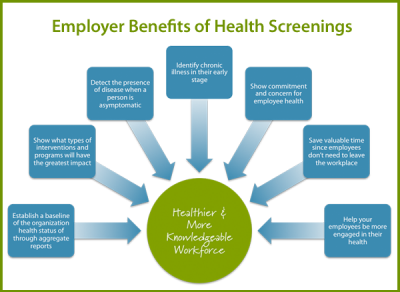Occupational health screening is a term used to describe a variety of employee health screenings required by employers.
Employee health screening is a term used to describe a variety of checks and tests that help identify risks to health and wellbeing among an employee.
Occupational health screenings can be required at various stages of the employment relationship, starting before a new hire is assigned to a particular job. These health screenings are generally used for the following purposes:
- To establish that candidates are able to meet the physical requirements of the job prior to assignment
- To monitor health status at periodic intervals when the job involves exposure to potential health hazards
- To establish that employees are able to return to work after a prolonged absence for health reasons
- To establish the conditions under which employees with illnesses, injuries or disabilities are able to continue working

Health Screenings have the potential of benefitting both employees and the companies they work for:
1.They offer lasting benefits to employees.
Required testing may be the reason for an employee to seek medical advice from a health problem they have been putting off. A health screening also may capture something undetectable by the e mployee reducing the risk of future illnesses.
mployee reducing the risk of future illnesses.
2. Lifestyle advises, or support.
If an employee is attempting to quit smoking or has a mental illness such as depression they could develop a relationship with a physician that can help them overcome life obstacles.
3.High levels of productivity.
requiring a health screening will reduce the risk of illnesses or injuries in the workplace.
An organization’s workforce is its most important asset, so it makes sense for managers to do what can be done to detect illness and promote health and wellbeing.
The World Health Organisation (WHO) identifies eight key risks factors to health, all of which could be addressed in a health check:
- Smoking.
- Drinking alcohol.
- Obesity.
- High blood pressure.
- High cholesterol.
- High blood glucose.
- Poor diet.
- Lack of exercise.
